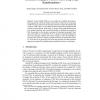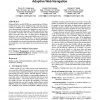69 search results - page 13 / 14 » Managing Product Line Variability by Patterns |
GTTSE
2007
Springer
14 years 1 months ago
2007
Springer
Abstract. Feature Models (FMs) are a key artifact for variability and commonality management in Software Product Lines (SPLs). In this context, the merging of FMs is being recogniz...
ASWSD
2006
Springer
13 years 11 months ago
2006
Springer
Automotive software has become an important factor in the development of modern and innovative high-end vehicles. More and more functions can only be realized by the cooperation of...
ICSE
2005
IEEE-ACM
14 years 7 months ago
2005
IEEE-ACM
Design for change is a well-known adagium in software engineering. We separate concerns, employ well-designed interfaces, and the like to ease evolution of the systems we build. W...
IEE
2008
13 years 7 months ago
2008
: Feature diagrams (FDs) are a family of popular modelling languages, mainly used for managing variability in software product lines. FDs were first introduced by Kang et al. as pa...
KDD
2002
ACM
14 years 7 months ago
2002
ACM
Relational Markov models (RMMs) are a generalization of Markov models where states can be of different types, with each type described by a different set of variables. The domain ...


